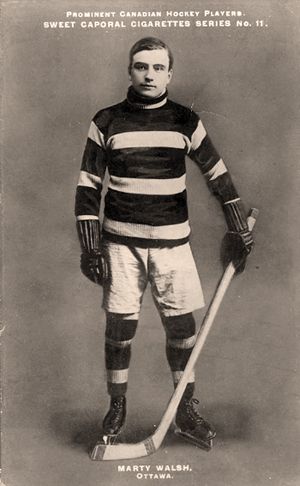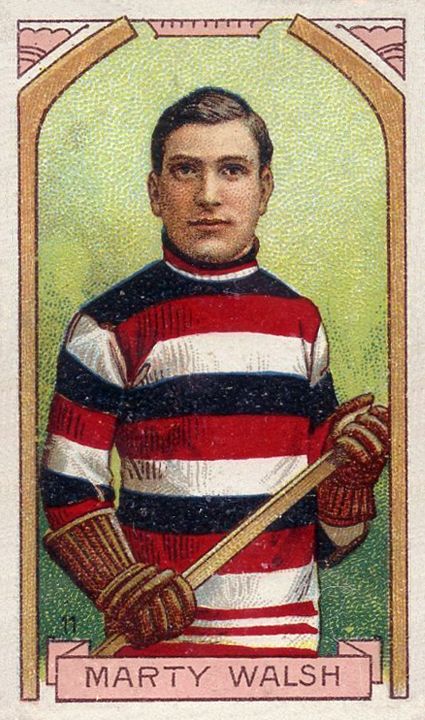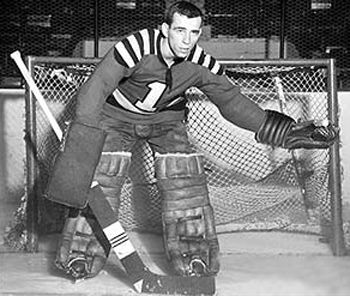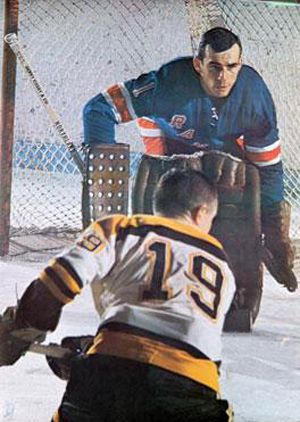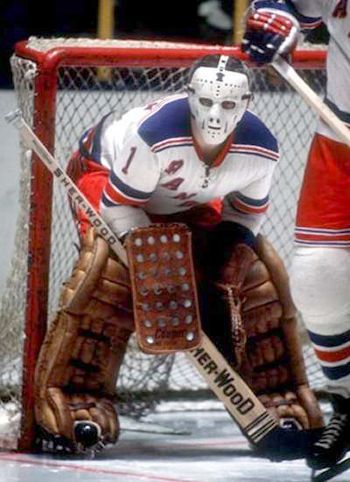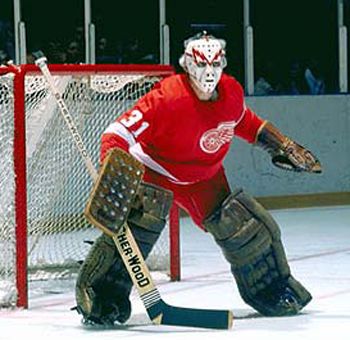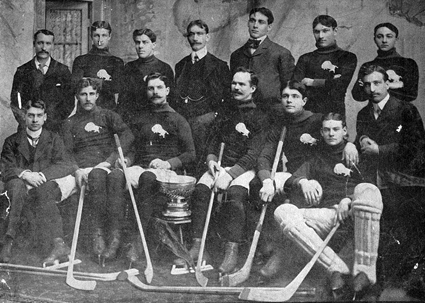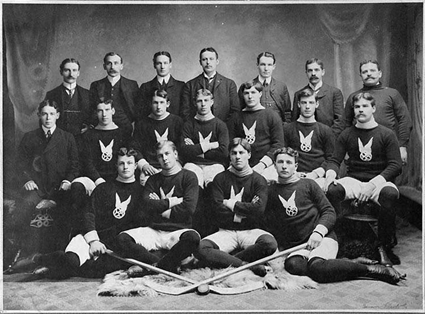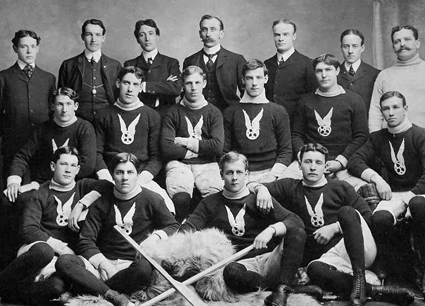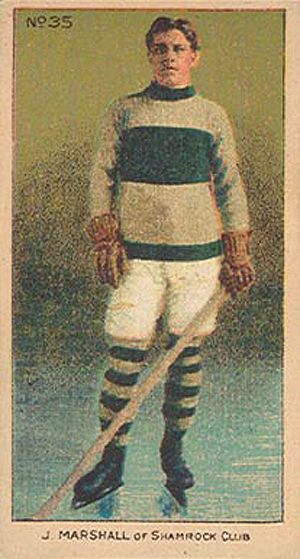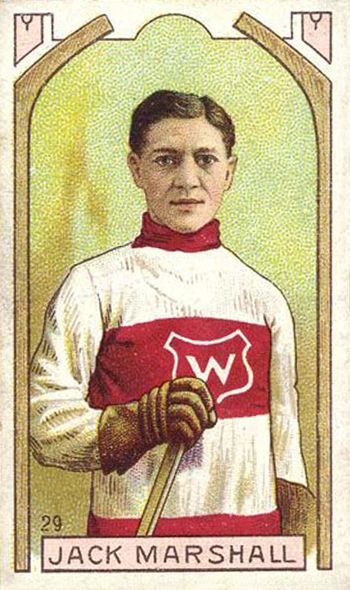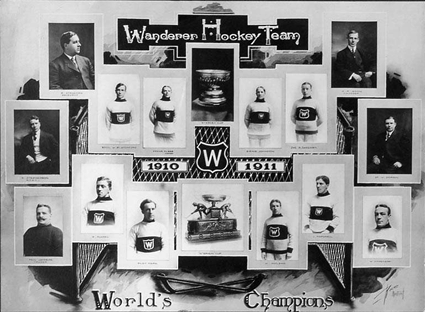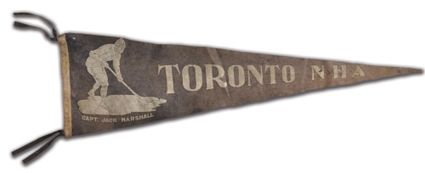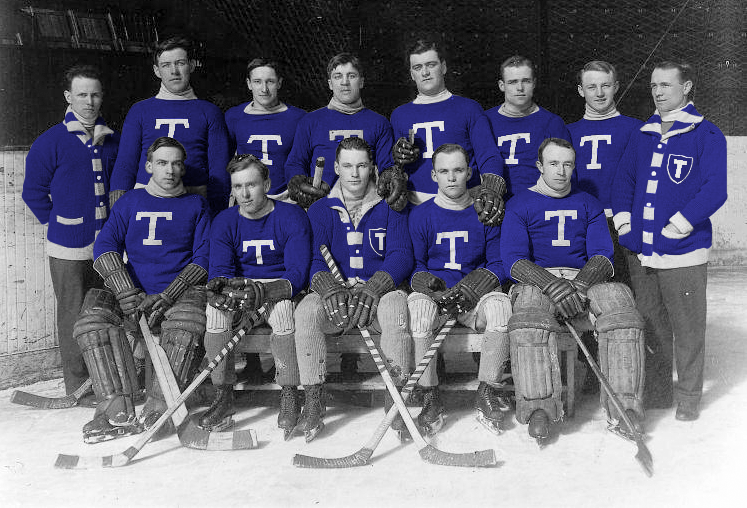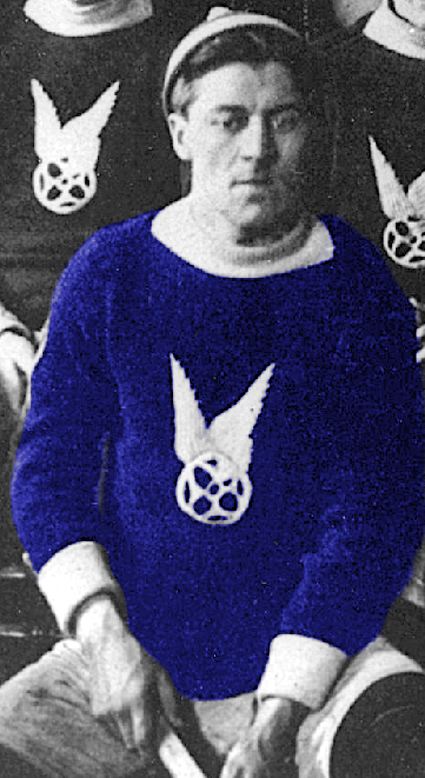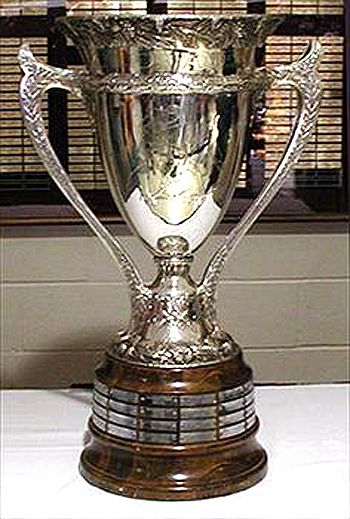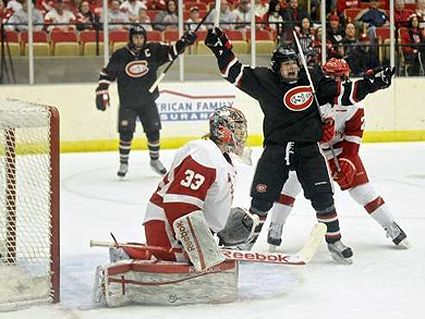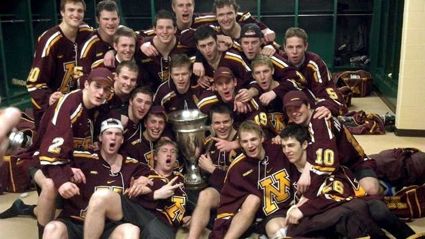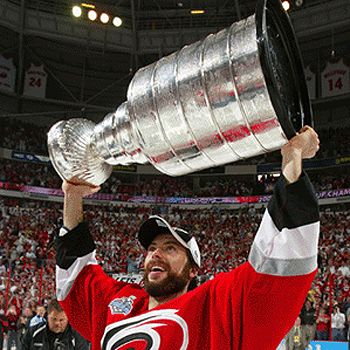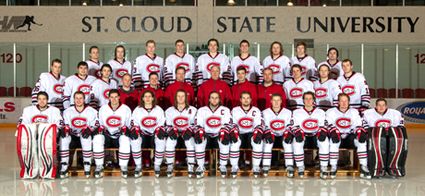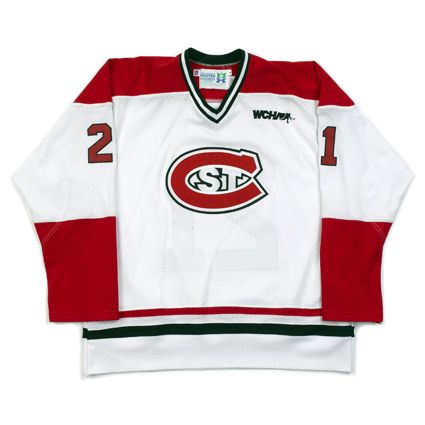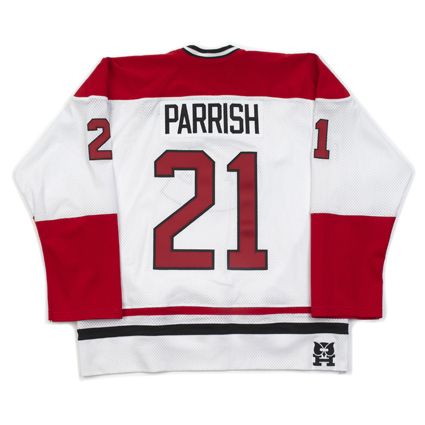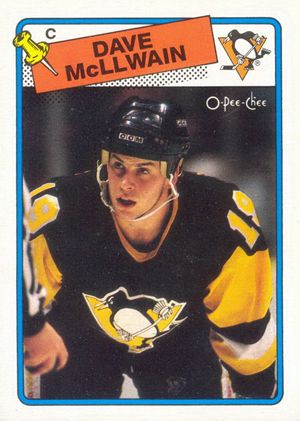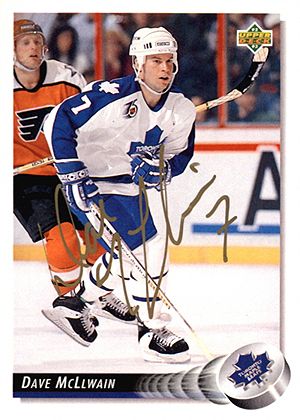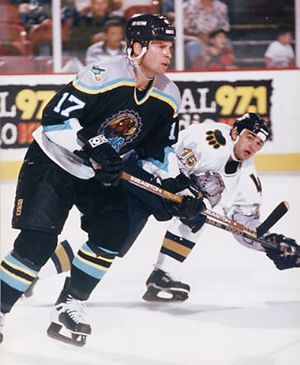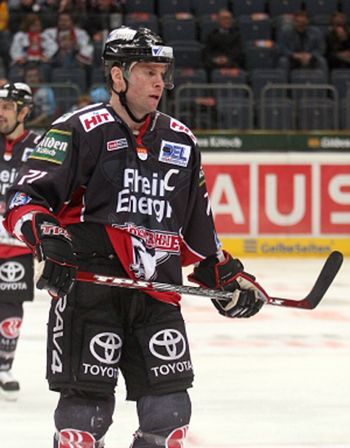Saturday, March 16, 2013
1910-11 Ottawa Senators Marty Walsh Jersey
Marty Walsh played in the Canadian Intercollegiate Hockey Union for Queen's University from 1902 through 1906, including a league championship in 1906 which led to a challenge for the Stanley Cup during which he scored four goals in two games versus the Ottawa Silver Seven.
The 1906 Queen's University team, which challenged for the Stanley Cup
with Walsh is seated second from the right in the front row
photo courtesy of Classic Auctions
Walsh turned professional in 1906-07 when he played for the Canadian Soo of the International Hockey League. Unfortunately, his season was limited to seven of 24 games due to a broken leg, but he gave a glimpse of his potential with four goals and five assists for nine points in limited action.
For the 1907-08 season Walsh moved back east to join the mighty Silver Seven, who had defended the Stanley Cup 11 times from March 1903 to March 1906. In his first season with Ottawa, Walsh made his presence known with 27 goals in nine games, including seven in one game against Montreal on March 7, 1908, to lead the league in scoring.
The following season Walsh again led the league in scoring with an astounding 42 goals in just 12 games, an average of 3 1/2 goals a game! The club, now known as the Senators, demolished the competition with a 10-2 mark while scoring 117 goals in their 12 games, quite nearly a ten goal per game average and no game with less than five. As Eastern Canada Hockey Association champions, the Senators became holders of the Stanley Cup.
As was often the case in the formative years of professional hockey, a dispute within the ECHA led to the Senators joining a brand new league for 1909-10, the Canadian Hockey Association. The league was a failure and Ottawa ended up playing just three league games as well as a pair of defenses of the Stanley Cup. Walsh scored nine goals in the two Senators CHA games he played and then six in the first game of the Senators defense of the cup against Galt.
When the CHA disbanded, Ottawa then became a member of the National Hockey Association for their schedule of games that season. Walsh came fourth in league scoring with 23 goals in 11 games as well as adding a pair of goals in a successful defense of the Stanley Cup against Edmonton of the Alberta Amateur Hockey Association. All told, Walsh scored 40 goals in 17 games that season but Ottawa had to relinquish the Stanley Cup to the NHA champion Montreal Wanderers.
Walsh had another stellar season in 1910-11 with 35 goals in 16 NHA contests to lead the league in scoring as the Senators won the league championship to regain possession of the Stanley Cup once more.
1911 Ottawa Senators - holders of the Stanley Cup
On March 13th, Galt once more challenged for the Stanley Cup and Walsh led the defense with three of the seven Ottawa goals to win 7-4.
Three days later, on this date in 1911, Port Arthur had the misfortune to face an on-form Walsh, who scored ten goals in a 13-4 win for the Senators.
In his final season of 1911-12, Walsh scored 9 times in 12 games to close out his carer. Following his playing days, Walsh moved to Edmonton and fell ill, passing away just two years later.
Walsh was inducted into the Hockey Hall of Fame in 1962.
Today's featured jersey is a 1910-11 Ottawa Senators Marty Walsh jersey. The Senators trademark red, black and white horizontal "barberpole" stripes were first adopted in 1903, and except for one season with vertical stripes in 1910-11, remained in use through the original Senators final season in Ottawa of 1933-34, with the addition of the letter "O" crest from 1929-30 on.
Labels:
Ottawa Senators,
Walsh Marty
Friday, March 15, 2013
1968-69 New York Rangers Ed Giacomin Jersey
On this date in 1989, the New York Rangers retired sweater #1 in honor of goaltender Ed Giacomin.
Giacomin's return to New York was an emotional one, as the Rangers fans chanted "Ed-die! Ed-die!", drowning out even the national anthem, a game that was voted one of the Top 50 moments in Madison Square Garden history, not just Rangers history, but all events at MSG, which include Elvis Presley and other concerts, legendary boxing matches, NBA and college basketball, political conventions and an appearance by the Pope.
Giacomin, overcoming serious burns suffered in a kitchen accident as a teenager when a stove exploded, played five seasons for the Providence Reds of the American Hockey League to start his professional career.
He then made his NHL debut with the New York Rangers in 1965-66 and led the NHL in shutouts with nine during his second season, helping the Rangers make the playoffs for only the second time in nine seasons.
He then made his NHL debut with the New York Rangers in 1965-66 and led the NHL in shutouts with nine during his second season, helping the Rangers make the playoffs for only the second time in nine seasons.
Once established as the Rangers starting goaltender, Giacomin would lead the league in games played for the next four seasons, seeing action in between 66 and 70 games while winning 30 games or more each of those four seasons with a high of 37 in 1968-69 and leading the NHL in shutouts again in 1967 with nine and 1968 with eight.
With the acceptance of goalies in the NHL sharing the duty now becoming the norm, Giacomin's games played would shrink to the mid 40's starting in 1970, but he would still lead the league in shutouts in 1971 with eight on his way to winning the Vezina Trophy along with partner Gilles Villemure.
The following season the Rangers would enjoy their greatest playoff success of Giacomin's career, making it to the Stanley Cup Finals.
Giacomin was limited by injuries in 1974-75, limiting him to just 37 games and 13 wins, his first time under 24 wins since becoming the starter in 1966-67. As a result, the Rangers, off to a bad start, began dumping their high priced veterans, which included waiving Giacomin, who was claimed by the Detroit Red Wings.
Giacomin's return to New York was an emotional one, as the Rangers fans chanted "Ed-die! Ed-die!", drowning out even the national anthem, a game that was voted one of the Top 50 moments in Madison Square Garden history, not just Rangers history, but all events at MSG, which include Elvis Presley and other concerts, legendary boxing matches, NBA and college basketball, political conventions and an appearance by the Pope.
He would finish his career by playing two seasons plus an additional nine games in 1977-78 with the Red Wings before retiring in January of 1978 with 609 games and a record of 289-209-96 and 54 shutouts and a goals against average of 2.82.
Giacomin played in the NHL All-Star Game six times, was inducted into the Hockey Hall of Fame in 1987 and his sweater #1, retired on this date in 1989, was only the second number retired by the Rangers in their 64 year history.
Today's featured jersey is a 1968-69 New York Rangers Ed Giacomin jersey as worn during the season he recorded his highest NHL win total of 37 games.
The Rangers diagonal crest dates back to their first season in the NHL in 1926-27 and changed to the current font in 1941 with the drop shadow first being added the following season. This particular style with the lace-up collar was first used in 1951 with sleeve numbers arriving in 1963.
After a radical change in style in 1976 and a return to a more traditional style which read "New York" on the front in 1978, the Rangers name returned to the blue jerseys in 1987 and this style with the lace up collar was reinstated in 1997 and remains in use today.
Today's video segment begins with the excellent Legends of Hockey profile on Eddie Giacomin which includes footage of his jersey retirement ceremony.
Here's evidence of the combative nature Giacomin possessed referred to by Stan Fischler in the previous video, as he goes after Garry Howatt of the Islanders. It's also an example of the "Ed-die! Ed-die!" chant that used to fill Madsion Square Garden.
Labels:
Giacomin Ed,
New York Rangers
Thursday, March 14, 2013
1902 Montreal Amateur Athletic Association Jack Marshall Jersey
One of Montreal's finest athletes of the early 20th century, Jack Marshall was born on this date in 1877. He excelled at rugby, soccer, baseball, lacrosse, bowling and hockey. His hockey career began in 1989 when he traveled west to join the Winnipeg Victorias. There, he played three seasons, which concluded with the Victorias defeating the Montreal Shamrocks two games to none at the Montreal Arena by scores of 4-3 and 2-1 in overtime.
Marshall moved back to Montreal for the 1901 season in order to join the Montreal Hockey Club, also known as Montreal AAA due to their association with the Montreal Amateur Athletic Association. In 8 games, Marshall scored 11 goals, good for third in the league. Montreal, as Canadian Amateur Hockey League champions then challenged the same Winnipeg Victorias that Marshall had helped win the Stanley Cup in January of 1901.
The best-of-three series was held in Winnipeg and the Victorias began their defense with a victory in Game 1 1-0, but Montreal evened the series two days late with a dominant 5-0 win, with Marshall scoring twice to force a deciding third game. In a close contest, Montreal emerged as 2-1 winners, with Marshall scoring the cup clinching goal to give him the second Stanley Cup of his career.
During the 1903 CAHL season, Montreal fended off a challenge from the Victorias in an unusual series, as Montreal dominated Game 1 by a score of 8-1 followed by the second game being suspended at 27 minutes of overtime due to a curfew and the result was discarded from the record. Winnipeg fought back to win Game "2" by a score of 4-2, but Montreal retained the cup with a 4-1 triumph in Game 3. In all, Marshall was credited with 7 goals in the four games played.
Although he remained in Montreal, Marshall wore new colors in 1904, joining the newly created Montreal Wanderers of the Federal Amateur Hockey League. Marshall was an instant success, leading the league with 11 goals even though he only skated in four of the Wanderers six games, aided with a six goal performance against Ottawa on January 20, 1904. In an odd twist, the Wanderers had finished first in the standings, only to have the reigning Stanley Cup holders, the Ottawa Hockey Club, also known as the Silver Seven, join the FAHL after the regular season was concluded!
With this unusual turn of events, the Wanderers and Silver Seven were set to play a two game series for the Stanley Cup as well as the FAHL championship. The first game concluded with the teams tied at 5-5, with Marshall having scored for Montreal before the club not only refused to play any overtime, but then requested that the game be declared a no-contest and the series start over as a best-of-three!
The trustees of the cup were not amused and demanded the series continue as a two game series and Montreal responded by abandoning their challenge so the cup remained with Ottawa.
The 1904-05 season saw Marshall finished tied with Ottawa's Frank McGee for the scoring title with 17 goals in 8 games played.
In the 1905-06 season, Marshall played exhibition games with the Toronto Professionals. He joined the Montreal Montagnards of the FAHL for the 1906-07 season, but returned to the Wanderers when the Montagnards folded. Marshall scored an identical 6 goals in three games for each club. Marshall returned to Stanley Cup play, as the Wanderers won the Eastern Canada Amateur Hockey Association regular season, but the Wanderers fell to the Kenora Thistles 12-8 over the course of two games.
Marshall spent the next two seasons with the Shamrocks, leading the club in scoring with 19 goals in 9 games in 1907-08 followed by 10 more in a dozen games in 1908-09.
For 1909-10, Marshall once again returned to the Wanderers, who had joined the new National Hockey Association.
The Wanderers became the Stanley Cup holders by winning the league championship, which entitled them to take possession of the cup from Ottawa, the third different team Marshall had won a cup with. The Wanderers then defended a challenge from the Berlin Dutchmen by a score of 7-3 in the single game played.
After two more seasons with the Wanderers, Marshall joined the brand new Toronto Hockey Club, commonly referred to as the Blueshirts, for the 1912-13 season. The following year Marshall, now a playing manager, skated in a career high 20 games, scoring 3 times but also being credited with his the first assists of his career with 3, as assists were not awarded in the early days of organized hockey.
After Toronto and the Montreal Canadiens finished tied atop the 1913-14 standings with identical 13-7 records, Toronto won the two-games, total-goals series after dropping the first game 2-0 by winning the second 6-0 with Marshall chipping in a goal for the Blueshirts, to earn another Stanley Cup with a record fourth different club. Toronto subsequently fended off a challenge from the Victoria Aristocrats of the PCHL, sweeping three straight in the scheduled best-of-five series.
Marshall would play one final season with the Blueshirts before yet again returning to Montreal, where he rejoined the Wanderers for the fourth time in his career! He would play 15 games in 915-16 and wrap up his career with 8 more games in the 1916-17 NHA season.
Marshall was inducted into the Hockey Hall of Fame in 1965 and remains the only player to win the Stanley Cup with four different clubs.
Today's featured jersey is a 1902 Montreal AAA Jack Marshall jersey. Also known as the Montreal Hockey Club, the Montreal Amateur Athletic Association (AAA) wore blue sweaters with adorned with a winged wheel, which would later be revived by James Norris, founder of the Detroit Red Wings as the Red Wings logo, which remains in use today.
The Montreal Hockey Club was founded in 1884 and was the first team to hold the brand new (and substantially shorter) Stanley Cup in 1893. They would also again be holders of the cup in 1894, 1902 and 1903.
The club would remain as amateurs until 1906, and after two seasons as a professional club, returned to the amateur ranks and eventually win the Allan Cup in 1930 and change their name to the Montreal Royals in 1932.
The Winnipeg Victorias
Marshall moved back to Montreal for the 1901 season in order to join the Montreal Hockey Club, also known as Montreal AAA due to their association with the Montreal Amateur Athletic Association. In 8 games, Marshall scored 11 goals, good for third in the league. Montreal, as Canadian Amateur Hockey League champions then challenged the same Winnipeg Victorias that Marshall had helped win the Stanley Cup in January of 1901.
The best-of-three series was held in Winnipeg and the Victorias began their defense with a victory in Game 1 1-0, but Montreal evened the series two days late with a dominant 5-0 win, with Marshall scoring twice to force a deciding third game. In a close contest, Montreal emerged as 2-1 winners, with Marshall scoring the cup clinching goal to give him the second Stanley Cup of his career.
The 1902 Montreal AAA
During the 1903 CAHL season, Montreal fended off a challenge from the Victorias in an unusual series, as Montreal dominated Game 1 by a score of 8-1 followed by the second game being suspended at 27 minutes of overtime due to a curfew and the result was discarded from the record. Winnipeg fought back to win Game "2" by a score of 4-2, but Montreal retained the cup with a 4-1 triumph in Game 3. In all, Marshall was credited with 7 goals in the four games played.
The 1903 Montreal AAA
Although he remained in Montreal, Marshall wore new colors in 1904, joining the newly created Montreal Wanderers of the Federal Amateur Hockey League. Marshall was an instant success, leading the league with 11 goals even though he only skated in four of the Wanderers six games, aided with a six goal performance against Ottawa on January 20, 1904. In an odd twist, the Wanderers had finished first in the standings, only to have the reigning Stanley Cup holders, the Ottawa Hockey Club, also known as the Silver Seven, join the FAHL after the regular season was concluded!
With this unusual turn of events, the Wanderers and Silver Seven were set to play a two game series for the Stanley Cup as well as the FAHL championship. The first game concluded with the teams tied at 5-5, with Marshall having scored for Montreal before the club not only refused to play any overtime, but then requested that the game be declared a no-contest and the series start over as a best-of-three!
The trustees of the cup were not amused and demanded the series continue as a two game series and Montreal responded by abandoning their challenge so the cup remained with Ottawa.
The 1904-05 season saw Marshall finished tied with Ottawa's Frank McGee for the scoring title with 17 goals in 8 games played.
In the 1905-06 season, Marshall played exhibition games with the Toronto Professionals. He joined the Montreal Montagnards of the FAHL for the 1906-07 season, but returned to the Wanderers when the Montagnards folded. Marshall scored an identical 6 goals in three games for each club. Marshall returned to Stanley Cup play, as the Wanderers won the Eastern Canada Amateur Hockey Association regular season, but the Wanderers fell to the Kenora Thistles 12-8 over the course of two games.
Marshall spent the next two seasons with the Shamrocks, leading the club in scoring with 19 goals in 9 games in 1907-08 followed by 10 more in a dozen games in 1908-09.
Marshall with the Shamrocks
For 1909-10, Marshall once again returned to the Wanderers, who had joined the new National Hockey Association.
The Wanderers became the Stanley Cup holders by winning the league championship, which entitled them to take possession of the cup from Ottawa, the third different team Marshall had won a cup with. The Wanderers then defended a challenge from the Berlin Dutchmen by a score of 7-3 in the single game played.
The 1911 Montreal Wanderers
After two more seasons with the Wanderers, Marshall joined the brand new Toronto Hockey Club, commonly referred to as the Blueshirts, for the 1912-13 season. The following year Marshall, now a playing manager, skated in a career high 20 games, scoring 3 times but also being credited with his the first assists of his career with 3, as assists were not awarded in the early days of organized hockey.
A Toronto Hockey Club pennant which features Captain Jack Marshall
photo courtesy of Classic Auctions
After Toronto and the Montreal Canadiens finished tied atop the 1913-14 standings with identical 13-7 records, Toronto won the two-games, total-goals series after dropping the first game 2-0 by winning the second 6-0 with Marshall chipping in a goal for the Blueshirts, to earn another Stanley Cup with a record fourth different club. Toronto subsequently fended off a challenge from the Victoria Aristocrats of the PCHL, sweeping three straight in the scheduled best-of-five series.
The 1913-14 Stanley Cup champion Toronto Hockey Club
Marshall would play one final season with the Blueshirts before yet again returning to Montreal, where he rejoined the Wanderers for the fourth time in his career! He would play 15 games in 915-16 and wrap up his career with 8 more games in the 1916-17 NHA season.
Marshall was inducted into the Hockey Hall of Fame in 1965 and remains the only player to win the Stanley Cup with four different clubs.
Today's featured jersey is a 1902 Montreal AAA Jack Marshall jersey. Also known as the Montreal Hockey Club, the Montreal Amateur Athletic Association (AAA) wore blue sweaters with adorned with a winged wheel, which would later be revived by James Norris, founder of the Detroit Red Wings as the Red Wings logo, which remains in use today.
The Montreal Hockey Club was founded in 1884 and was the first team to hold the brand new (and substantially shorter) Stanley Cup in 1893. They would also again be holders of the cup in 1894, 1902 and 1903.
The club would remain as amateurs until 1906, and after two seasons as a professional club, returned to the amateur ranks and eventually win the Allan Cup in 1930 and change their name to the Montreal Royals in 1932.
Labels:
Marshall Jack,
Montreal AAA
Tuesday, March 12, 2013
1996-97 St. Cloud State Huskies Mark Parrish Jersey
The final weekend of the Western Collegiate Hockey Association season took place this past weekend, the final year for the current configuration before Minnesota and Wisconsin leave for the Big Ten Hockey Conference and Denver, Colorado College, North Dakota, Nebraska-Omaha, Minnesota-Duluth and St. Cloud State all leave for the National Collegiate Hockey Conference.
The final weekend came down to St. Cloud State, Minnesota and North Dakota all with a shot at the regular season championship, and with it the historic and gorgeous MacNaughton Cup, which is awarded to the league in which Michigan Tech is a member. The cup dates back to 1913 and was originally purchased for $2,000, a hefty sum back in those days and the equivalent of $46,500 today.
The cup was originally awarded to the champion of the American Hockey Association until 1932. Through 1950, the cup was given to semi-pro and intermediate teams in Michigan's Copper Country until the family of James MacNaughton arranged to have the cup awarded to the regular season champion of the newly founded Midwest Collegiate Hockey League, which eventually led to the creation of the WCHA in 1959.
With Michigan Tech being trustees of the cup, it did follow them to the Central Collegiate Hockey Association in 1981-82, but returned to the WCHA in 1984-85 when they rejoined the league after three seasons away.
The St. Cloud State Huskies led going into the weekend with 35 points, with the Minnesota Golden Gophers and the North Dakota (no longer the Fighting Sioux) 2 back with 33 each. St. Cloud clinched at least a tie for a share of the championship with a 4-2 win over the Wisconsin Badgers at Madison, while Minnesota outlasted the feisty Bemidji State Beavers 4-3 and North Dakota kept pace with a 4-3 win on the road against the Minnesota State Mavericks, taking the fight down to the final day with the rights to the cup still undecided.
Minnesota took care of business over ninth place Bemidji State 5-1, putting pressure on the other two, who were having a much tougher time of things. The Mavericks were even with North Dakota 1-1 as play entered the third period. Meanwhile, Wisconsin lead 2-1 after two against St. Cloud.
As time wound down, the Huskies pulled their goaltender in an effort to even their game against Wisconsin, only to have the Badgers score with 1:13 left in the game. While St. Cloud managed a late goal with 33 seconds remaining, it was too little, too late and the Huskies fell to the Badgers and into a tie with Minnesota at 35 points each.
North Dakota now needed a win to force a three way tie for the regular season title, but they could not find a way to crack the Minnesota State defense as a fired up Mavericks actually out shot North Dakota 29-13 over the final two periods of the game, which ended regulation tied 1-1. Minnesota State then cost North Dakota a share of the championship with a game winning goal at 3:22 of overtime.
Still in possession of the MacNaughton Cup, having won it last season, the coach of Minnesota, Don Lucia, had one of his assistant coaches secretly bring the cup up to Bemidji in the trunk of his car. With the Minnesota players game having finished first, the became aware of the results of the other two games while in their dressing room following their game, whereupon the coaching staff retrieved the hidden trophy from the parking lot and surprised the players when they presented to them in the locker room!
The share of the league championship was the first for St. Cloud State, who joined the WCHA back in 1990 after moving up to Division I in 1987. The program was founded back in 1931 and was a Division II and Division III contender, with their final season being under the guidance of the legendary Herb Brooks, head coach of the 1980 United States Olympic "Miracle on Ice" team. During Brooks only season behind the Huskies bench, the team broke or tied no less than 45 school records on their way to a third place finish nationally.
Their move to Division I was aided by the construction of a new home arena, the National Hockey Center as the Huskies began life as a Division I independent team. Their first season of 1987-88 was highlighted by a win over the third ranked Lake Superior State Lakers. Their second season saw them not only finish with a winning record, but earned their first invitation to the NCAA playoffs.
St. Cloud State then was accepted into the WCHA for the 1990-91 season, finishing fifth overall. The Huskies finished the 2000-01 season with a school best 31-9-1 record, 20-8-0 in the WCHA, and went on to win the WCHA playoff championship, defeating North Dakota in the final game. In addition to winning the playoff championship in 2001, St. Cloud State placed second in 1994, 2006 and 2010.
In addition, the Huskies have been selected for the NCAA national championship tournament in 1989, 2000, 2001, 2002, 2003, 2007, 2008 and 2010, but with limited results, as they currently have a 1-9 record with their first win coming in 2010 against Northern Michigan 4-3 in two overtimes.
Noteworthy Huskies who have gone onto the NHL include Tyler Arnason, Stanley Cup winners Bret Hedican and Matt Cullen, Olympic silver medalist Ryan Malone and Mark Parrish with Cullen being the highest drafted at #35 in the second round.
St. Cloud will enter the WCHA playoff this coming weekend as the #1 seed and will host the University of Alaska - Anchorage Seawolves as they look to return to St. Paul, Minnesota in hopes of adding the Broadmoor Trophy as playoff champions in their final season in the WCHA to their first MacNaughton Cup, which will be presented to them in front of their home fans this weekend.
Today's featured jersey is a 1996-97 St. Cloud State Huskies Mark Parrish jersey. At the time, the Huskies home white jersey was a virtual copy of the classic Montreal Canadiens jersey, only this time with a clever take on the Canadiens iconic "CH" logo by swapping out the "H" for an "ST". This gave the Huskies an instantly familiar appearing logo that says "hockey" at first glance, but rewards the viewer on closer inspection. Additionally, while the jersey pattern is the same, the Huskies employ red, black and white as team colors, allowing them to avoid the criticism of simply copying the NHL club's jersey stitch for stitch.
The final weekend came down to St. Cloud State, Minnesota and North Dakota all with a shot at the regular season championship, and with it the historic and gorgeous MacNaughton Cup, which is awarded to the league in which Michigan Tech is a member. The cup dates back to 1913 and was originally purchased for $2,000, a hefty sum back in those days and the equivalent of $46,500 today.
The MacNaughtonCup
The cup was originally awarded to the champion of the American Hockey Association until 1932. Through 1950, the cup was given to semi-pro and intermediate teams in Michigan's Copper Country until the family of James MacNaughton arranged to have the cup awarded to the regular season champion of the newly founded Midwest Collegiate Hockey League, which eventually led to the creation of the WCHA in 1959.
With Michigan Tech being trustees of the cup, it did follow them to the Central Collegiate Hockey Association in 1981-82, but returned to the WCHA in 1984-85 when they rejoined the league after three seasons away.
The St. Cloud State Huskies led going into the weekend with 35 points, with the Minnesota Golden Gophers and the North Dakota (no longer the Fighting Sioux) 2 back with 33 each. St. Cloud clinched at least a tie for a share of the championship with a 4-2 win over the Wisconsin Badgers at Madison, while Minnesota outlasted the feisty Bemidji State Beavers 4-3 and North Dakota kept pace with a 4-3 win on the road against the Minnesota State Mavericks, taking the fight down to the final day with the rights to the cup still undecided.
St. Cloud clinched a share of their first title Friday vs. Wisconsin
Minnesota took care of business over ninth place Bemidji State 5-1, putting pressure on the other two, who were having a much tougher time of things. The Mavericks were even with North Dakota 1-1 as play entered the third period. Meanwhile, Wisconsin lead 2-1 after two against St. Cloud.
As time wound down, the Huskies pulled their goaltender in an effort to even their game against Wisconsin, only to have the Badgers score with 1:13 left in the game. While St. Cloud managed a late goal with 33 seconds remaining, it was too little, too late and the Huskies fell to the Badgers and into a tie with Minnesota at 35 points each.
North Dakota now needed a win to force a three way tie for the regular season title, but they could not find a way to crack the Minnesota State defense as a fired up Mavericks actually out shot North Dakota 29-13 over the final two periods of the game, which ended regulation tied 1-1. Minnesota State then cost North Dakota a share of the championship with a game winning goal at 3:22 of overtime.
Still in possession of the MacNaughton Cup, having won it last season, the coach of Minnesota, Don Lucia, had one of his assistant coaches secretly bring the cup up to Bemidji in the trunk of his car. With the Minnesota players game having finished first, the became aware of the results of the other two games while in their dressing room following their game, whereupon the coaching staff retrieved the hidden trophy from the parking lot and surprised the players when they presented to them in the locker room!
The Gophers with the MacNaughton Cup
The share of the league championship was the first for St. Cloud State, who joined the WCHA back in 1990 after moving up to Division I in 1987. The program was founded back in 1931 and was a Division II and Division III contender, with their final season being under the guidance of the legendary Herb Brooks, head coach of the 1980 United States Olympic "Miracle on Ice" team. During Brooks only season behind the Huskies bench, the team broke or tied no less than 45 school records on their way to a third place finish nationally.
Their move to Division I was aided by the construction of a new home arena, the National Hockey Center as the Huskies began life as a Division I independent team. Their first season of 1987-88 was highlighted by a win over the third ranked Lake Superior State Lakers. Their second season saw them not only finish with a winning record, but earned their first invitation to the NCAA playoffs.
St. Cloud State then was accepted into the WCHA for the 1990-91 season, finishing fifth overall. The Huskies finished the 2000-01 season with a school best 31-9-1 record, 20-8-0 in the WCHA, and went on to win the WCHA playoff championship, defeating North Dakota in the final game. In addition to winning the playoff championship in 2001, St. Cloud State placed second in 1994, 2006 and 2010.
the 2001 WCHA playoff champion St. Cloud State Huskies
In addition, the Huskies have been selected for the NCAA national championship tournament in 1989, 2000, 2001, 2002, 2003, 2007, 2008 and 2010, but with limited results, as they currently have a 1-9 record with their first win coming in 2010 against Northern Michigan 4-3 in two overtimes.
Noteworthy Huskies who have gone onto the NHL include Tyler Arnason, Stanley Cup winners Bret Hedican and Matt Cullen, Olympic silver medalist Ryan Malone and Mark Parrish with Cullen being the highest drafted at #35 in the second round.
Matt Cullen hoists the Stanley Cup
St. Cloud will enter the WCHA playoff this coming weekend as the #1 seed and will host the University of Alaska - Anchorage Seawolves as they look to return to St. Paul, Minnesota in hopes of adding the Broadmoor Trophy as playoff champions in their final season in the WCHA to their first MacNaughton Cup, which will be presented to them in front of their home fans this weekend.
The 2012-13 WCHA champion St Cloud State Huskies
Today's featured jersey is a 1996-97 St. Cloud State Huskies Mark Parrish jersey. At the time, the Huskies home white jersey was a virtual copy of the classic Montreal Canadiens jersey, only this time with a clever take on the Canadiens iconic "CH" logo by swapping out the "H" for an "ST". This gave the Huskies an instantly familiar appearing logo that says "hockey" at first glance, but rewards the viewer on closer inspection. Additionally, while the jersey pattern is the same, the Huskies employ red, black and white as team colors, allowing them to avoid the criticism of simply copying the NHL club's jersey stitch for stitch.
St. Cloud took a different approach to their road jersey, going in an entirely different direction than Montreal's iconic red jersey with it's blue chest stripe, and created a menacing all black jersey, but still in a simple, classic style.
Today's video segment begins with St. Cloud State's first NCAA tournament victory in team history in March of 2010 in double overtime after seven previous appearances, all of which ended in defeat.
With St. Cloud down by a goal, here is a dramatic goal by the Huskies Ben Hanowski when he scored as time expired. Or did he?
Finally, a look at the National Hockey Center, home of the St. Cloud State Huskies.
Labels:
St. Cloud State,
WCHA
Monday, March 11, 2013
2004-05 Cologne Sharks Dave McLlwain Jersey
On this date in 1992, Dave McLlwain played his first game with the Toronto Maple Leafs, tying Dennis O'Brien's NHL record, as it was McLlwain's fourth different team of the season!
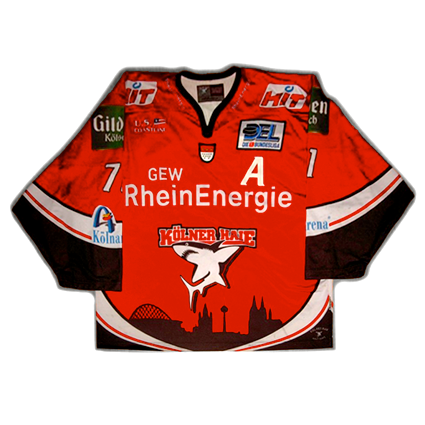
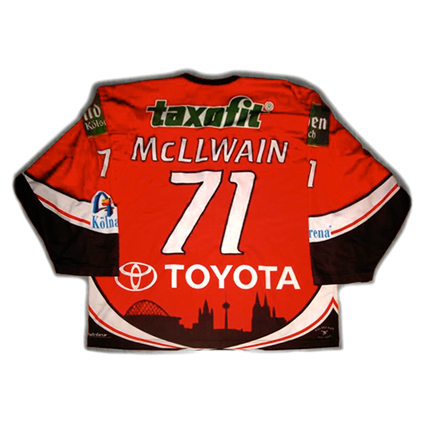
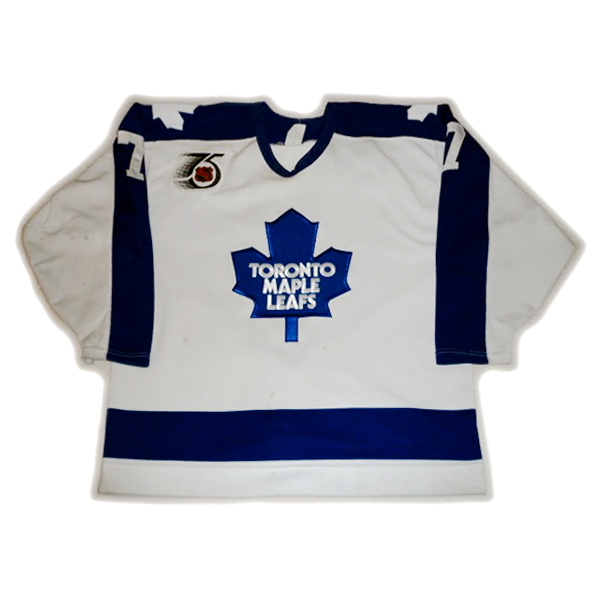
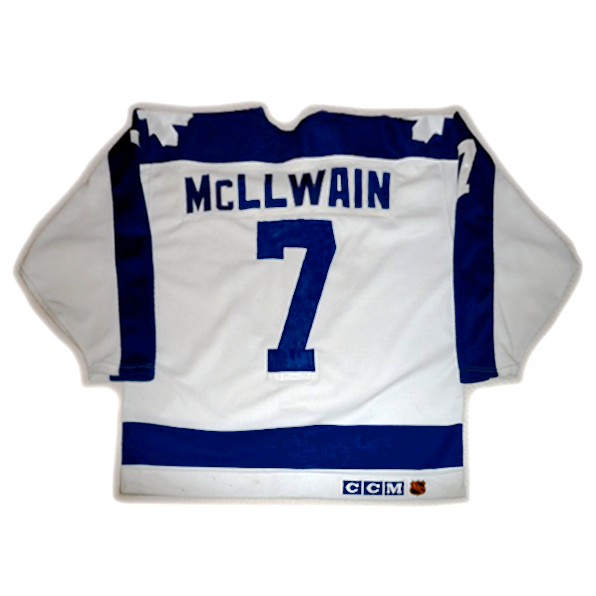
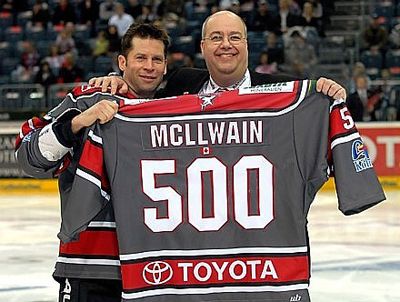
To read more on McLlwain, here is an extensive interview with "the heart, soul and brain" of the Cologne Sharks from their own website.
McLlwain was drafted by the Pittsburgh Penguins 172nd overall in the 1986 NHL Entry Draft and began his tour of the NHL with the Pittsburgh Penguins in 1987-88 by playing 66 games. He spent most of the following season with the Muskegon Lumberjacks of the IHL, but did get into 24 games with the Penguins.
The Penguins dealt him to the Winnipeg Jets for the 1989-90 season, in which he would have his best NHL season, scoring 25 goals and 26 assists for 51 points. Limited to 60 games in 1990-91, his production declined to 25 points.
The 1991-92 season began with McLlwain playing three games for the Jets, but was traded on October 11th to the Buffalo Sabres. His stay in Buffalo was brief, as having played just five games, McLlwain was on his way to the New York Islanders as part of the blockbuster deal involving Pierre Turgeon that brought Pat Lafontaine to the Sabres on October 25th.
McLlwain played 54 games for the Islanders, scoring 23 points, but then was dealt yet again to the Toronto Maple Leafs on March 10, 1992, where he played the final 11 games of the season and tied the NHL record by suiting up for his forth different NHL club of the season on this date in 1992.
In all, McLlwain played in 73 games that season, scoring 10 goals and 18 assists for 28 points, no doubt affected by the constant upheaval and time spent integrating into each club's schemes and learning his ever-shifting linemates.
He was able to call Toronto home for the entirety of the 1992-93 season, but was claimed by the Ottawa Senators in the waiver draft for the following season. He responded with 17 goals and 26 assists for the second highest total of his NHL career of 43 points.
McLlwain was limited to just 43 games in 1994-95 and spent most of 1995-96 with the Cleveland Lumberjacks of the IHL, scoring 75 points in 60 games, as well as appearing in 18 games with the Penguins, who acquired McLlwain from Ottawa.
After splitting time between the Lumberjacks, 75 points in 63 games, and the New York Islanders, where he played in four games, McLlwain's NHL career came to a close. His NHL totals were 501 games played, 100 goals and 107 assists for 207 points.
Even though McLlwain's NHL career was at an end, his playing days were far from over, as he spent the 1997-98 season with the Landshut Cannibals of the German DEL and the following two seasons with SC Bern of the Swiss National League A where he averaged more than a point per game, with 103 in 84 games.
Having played for 21 clubs in 13 seasons, McLlwain finally found stability when he signed with the Cologne Sharks (Kölner Haie) of the DEL, where he played nine seasons, winning a championship in 2002 and leading the team in scoring four times, 2003, 2004, 2006 and 2007 (the latter two leading the entire DEL) and was also named team captain.
Today's featured jersey is a 2004-05 Kölner Haie (Cologne Sharks) Dave McLlwain jersey. This jersey is very representative of the typical European club team jersey, with all the elements of the basic jersey being dye-sublimated and numerous sponsorship logos, with perhaps a few being sewn on from time to time.


Today's bonus jersey is a 1991-92 Toronto Maple Leafs Dave McLlwain jersey as worn when McLlwain tied the NHL record by playing with the Maple Leafs, his fourth different team in that season.
This jersey features the NHL 75th Anniversary patch as worn on all players jerseys during the 1991-92 season.


Extra Bonus jersey: Here is the jersey presented to Dave McLlwain in the occasion of this 500th game in the DEL.

Today's video section begins with a goal by McLlwain during his rookie season with the Penguins when he knocks a puck out of mid-air past John Vanbiesbrouck of the New York Rangers.
Next, we feature a tribute to McLlwain that recounts his entire career, from the Kitchner Rangers in junior hockey, to the Pittsburgh Penguins representing the NHL portion of his career and then his time with Cologne in the DEL.
Sorry about the Whitney Houston as the choice of music. Germans. What can you say? These are the same people who like David Hasslehoff.
To read more on McLlwain, here is an extensive interview with "the heart, soul and brain" of the Cologne Sharks from their own website.
Labels:
Cologne Sharks,
DEL,
McLlwain Dave
Subscribe to:
Comments (Atom)


